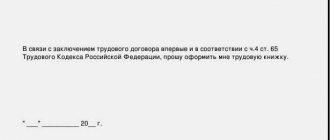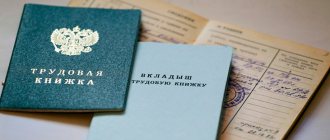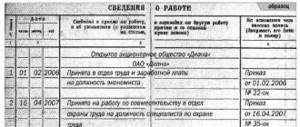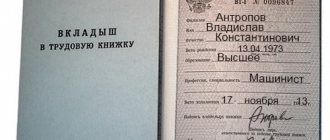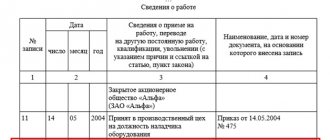Home / Labor Law / Labor book
Back
Published: 06/20/2018
Reading time: 5 min
2
447
Work books belong to strict reporting forms. Current legislation obliges all legal entities and entrepreneurs to maintain them. The document records the periods of work of the owner of the work book.
- Series and numbers
- How to check a document by series and number
- Validity
Work books by series and years
Despite the ongoing talk about the abolition of work books, such a decision has not been finally made by the Government, so people involved in personnel records should have an idea of what the document looks like correctly .
First of all, this is necessary to exclude counterfeit or invalid forms .
Compliance with the year of issue and the series of the work book, according to the Labor Code of the Russian Federation.
Sample 1973 (AT - TK series)
Sample 2003
Series and numbers from 1974 to 2003.
| No. | AT | Release time |
| 1 | I | 1974, 1975,1976 |
| 2 | II | 1977,1978,1979 |
| 3 | III | 1980,1981,1982 |
| 4 | IV | 1983,1984,1985 |
| 5 | V | 1986,1987,1988,1989 |
| 6 | VI | 1990,1991,1992 |
| 7 | VII | 1993,1994,1995,1996,1997 |
| 8 | VIII | 1998,1999, 2000 |
| 9 | IX | 2001, 2002, June 2003 |
| 10 | X | July 2003 – December 2003 |
Forms from different years
According to the legislation in force in Russia, there are four official types of work books. The standards for entering information, maintaining and handling this documentation are regulated by:
- Decree of the Government of the Russian Federation of April 16, 2003 No. 225 “On work books”.
- Resolution of the Ministry of Social Labor of the Russian Federation dated October 10, 2003 No. 69 “On approval of instructions for filling out work books.”
How are work books different? differences in appearance and content :
- 1938 - missing number and series;
- 1938 - reverse order of entering the date;
- 1938 - purple, 1973 - green, 2004 - gray;
- Since 1973 - has watermarks;
- Since 1973 - they have the inscription “Goznak” on the last page;
- Since 2004 - a special seam that prevents the replacement of sheets.
How to fill out the insert
Each insert in the book, like the original itself, has its own number and series, which must be indicated on the title page of the insert. It is worth recalling that the work book insert cannot exist as a separate document. It is not recognized as valid without the original. This auxiliary document is filled out in the same order as the labor document itself.
To make it easier for the employer or his authorized employee from the HR department to determine the year of issue of a particular work record book that an employee presents, every year new samples are released with different series.
Why do you need a work book number?
If you look meticulously, then knowing the series and number assigned to the work book, you can establish its authenticity. This can be useful when there are doubts about the authenticity of a document provided by an employee.
In practice, labor records are checked extremely rarely, and the presence of a series and number, watermarks and other security attributes only indicates that this is an official Goznak form .
It is extremely difficult to verify the veracity of the information entered into it, because a huge number of companies offer already completed forms with any records of acquired experience.
History of existence
The starting point, that is, the time when work books are recognized as an official document for determining a citizen’s length of service, is considered to be 1939. In December 1938, the famous decree of the Council of People's Commissars of the USSR was issued, which stated that from January 15, 1939, work books were introduced to record workers and employees. They began to include the now traditional list of information:
- Full name of the citizen;
- full age;
- education (higher, secondary and other);
- professional skills;
- job information;
- information about transferring to another place of work;
- reasons for moving to another job;
- incentives;
- awards and other important notes about a person's work and activities.
Further, the state introduced other samples of the same documents. They were improved, but mostly resembled the original model introduced in 1939. The books by year of publication differed mainly only in some changes in design and additional pages or sections, insert forms.
Since 1974, numbering and series have appeared. And in modern work books there are special security elements that allow you to maintain a high degree of protection against forgery and falsification.
The new samples have the same security elements that are used to print money - microprinting, embedded fibers, visible holograms, imprinted watermarks and careful printing. The printed elements used are almost impossible to display using the artisanal method using household devices. To print these forms, a special ink composition and many other tricks are used, which make it possible to protect honest citizens and companies almost 100% from fraudulent schemes.
Modern digital technologies make it possible to compete with state printing factories in the production of such documents. However, an expert will distinguish a fake quickly enough and confirm or deny the veracity of the entered data. Thus, this document, invented at the beginning of the last century, still helps protect the right to work and will help defend earned experience.
Liner
In the professional activities of some citizens, there comes a time when the “Work Information” is completely filled out and there is nowhere to enter new data. Some employers find creative ways out of the situation, for example, entering information into the “Award Information” section, crossing out the title inscription on the page, or filing blank sheets of paper.
None of the above actions are acceptable. If the “Work Information” column in the work book is full, the employee is given an insert . Information about it is entered on the title page, in the upper right corner . Indication of the series and number of the issued insert is mandatory.
It is possible to either enter information by hand or fill out a 10x25 mm stamp imprint. The numbering of entries during the design of the insert continues.
Information about the education and personal data of the employee is filled out on the basis of the documents provided, and not the title page of the employment record, since personal data may well have changed since the moment of first employment, a higher level of education has been obtained.
Like work books, inserts in them can be compared by series and year of issue .
Series of inserts for work books and year of issue
What are the series of inserts?
Inserts for the work book first appeared in 1974. They were introduced by Decree of the All-Union Central Council of Trade Unions, Council of Ministers of the USSR No. 656 of 1973. Work books of that time had the “AT” series. 4 series of inserts were released for them. In particular, the following series were used: “AT-I” (1974-1980), “AT-II” (1981-1987), “AT-III” (1988-1994), “AT- IV" (1995-2003).
Since 2004, along with the development and approval of new labor models, inserts of the “VT” series, black in color, began to be used. It is also differentiated depending on the year, namely:
- The "VT" series was used from 2004 to 2012.
- Series "VT-I" - from 2013 to 2021
Consequently, in 2021, labor forms have the “TK-V” series, and the inserts for them have the “VT-I” series. A serial number is also added to the liner series. It is printed in red. That is, the principle of its design is the same as the employment form.
For example, the series with the number “VT-I No. 5487655” of the insert corresponds to the labor sample that is used in the current year 2021. What is characteristic is that this series is also made in black, and the number assigned to it is in red. Standardly, when registering it, a stamp with o. is affixed to the labor document.
Important! An insert without labor is considered invalid. If it is not sewn in, but simply inserted, pinned or attached with a paper clip, then it has no force and is also not recognized.
Forms of work books
The legislation of the Russian Federation establishes several types of work book forms recognized as valid and not subject to mandatory replacement:
- Blank 1938;
- Blank 1973;
- Work book of a collective farmer on letterhead from 1975;
- Form 2004.
The data indicated in all these documents is the same, although the principles of entry are slightly different. In the column “Employee Information”:
Fill in:
- Full Name.
- Date of Birth.
- Owner's signature.
- Date of issue.
- Information about assigned qualifications and education.
- The official seal of the company issuing the work book is affixed.
- The signature of the personnel service employee who filled out the work book is entered.
Now let's look at the differences between all these types.
Insert in the work book, what year by number
The pages were protected with watermarks, making them difficult to counterfeit.
On the last page there was a note “Goznak.1974”. These forms have been discontinued since 2004, but are still used by some employees. That is, if an employee brings you his document of experience, which has AT-II details, and he is already of pre-retirement age, then most likely everything is fine with this person and his document.
But if such a document is brought by a person aged about thirty, and even with a sewn-in insert, this will make you at least think about the authenticity of the documents provided and the motives of the person who provided it. Since 2004, TC forms began to be issued. Currently, a work book of the TK V series is being issued.
This document is smaller in size than its predecessor and is gray in color. TK forms have a small format and a gray cover. On the cover is the coat of arms of Russia.
AT - I 1975, 1976 photo 2. AT - II 1977, 1978, 1979 photo 3. AT - III 1980, 1981, 1982 photo 4. AT - IV 1983, 1984, 1985 photo 5. AT - V 1986, 1987, 1988, 1989 photo 6. AT - VI 1990, 1991, 1992
photo 7. AT - VII 1993, 1994, 1995, 1996, 1997 photo 8. AT - VIII 1998, 1999, 2000 photo 9. AT - IX 2001, 2002, - first half of 2003 photo 10. AT - X second half of 2003 photo All work books from 1975 to 1992 were issued in a dark green thick cover.
Since 1992, in addition to the dark green, a light blue cardboard cover has appeared. The difference between them is only in appearance; both were in circulation. All pages of work books of the AT series are protected by watermarks in the form of serpentine curved lines, visible to the light.
Labor books of the TK series (2004-present) Since January 2004, the form of the work book has changed.
Attention The series and number of the insert must be indicated on the first page of the work book itself. The numbering of job information should be continued rather than started over.
The title page of the insert must be filled out on the basis of the documents provided, and not simply copied from the work report. It is unacceptable. Like the work form, the insert can also be checked by number and series.
Forms There are several types of work books established by law, which are recognized as valid and are not subject to mandatory replacement. These include:
- Document 1938
- Document 1973
- Collective farmer's labor card, model 1975.
- Document 2004
The data that must be entered into the labor records of any year is the same, although the principles of entry are somewhat different.
You can check the work book number by year of issue by checking the information indicated in the table below. The series and numbers of work books by year are indicated in ascending order: Series and numbers from 1974 to 2003.
No. AT Release time 1 I 1974, 1975,1976 2 II 1977,1978,1979 3 III 1980,1981,1982 4 IV 1983,1984,1985 5 V 1986,1987,1988,1989 6 VI 1990,1991, 1992 7 VII 1993,1994,1995,1996,1997 8 VIII 1998,1999, 2000 9 IX 2001, 2002, June 2003 10 X July 2003 – December 2003 Work book series TK V (from 2004 to the present) No. p/ p TK Time of issue 1 TK 2004, 2005 2 I 2006, 2007 3 II 2008, 2009, 2010 4 III 2011, 2012 5 IV 2013, 2014 – October 2015 6 V from October 2015 How the series and numbers of work books were distributed by year. The years of issue of AT forms were determined by the form number, which was printed in red on the first page.
A suspicion arises that the book could have been forged or simply deceived by a gullible and uninformed employee. In this regard, you need to learn more about the specifics of the production and functioning of work books.
This information will definitely help you properly carry out personnel production and feel confident when meeting with an unusual TC. ... Dear readers! Our articles talk about typical ways to resolve legal issues, but each case is unique.
If you want to find out how to solve your particular problem, please use the online consultant form on the right or call.
Delivery of work book forms and its insert is carried out under guard, using units of the State Courier Service of the Russian Federation, the Main Center for Special Communications (Special Communications) of the Ministry of Information and Communications of Russia, the Ministry of Internal Affairs of the Russian Federation or departmental security of federal executive authorities.
Based on the approved form of the work book, the coat of arms of the Russian Federation and the inscription “WORK BOOK” are located on the cover of the document. On the first title page, in addition to information about the employee, there is also a corresponding inscription and coat of arms (in the upper left corner), while the series and number of the document are indicated on every fourth page.
Features of the design of inserts in the work book The work book is designed for a fairly large amount of information entered. However, sometimes it happens that the personnel officer has nowhere to enter data in the “Job Information” section. Then it becomes necessary to draw up an insert in the work book.
These are legal actions. It is clear that sometimes there are illegal ones:
- pasting white blank sheets of plain paper into the work book}
- using blank pages of another work book as an insert}
- correction of the title of the section “Information about awards” to “Information about work”, which is also incorrect.
The legislation of the Russian Federation states that the subject of labor relations - the employer - is obliged to provide each employee of his enterprise with a work book, as well as the required number of inserts in it. In the information section about the employee, the following is usually entered:
- employee details;
- Date of Birth;
- employee signature;
- date of document execution;
- information about assigned qualifications;
- education information;
- stamp of the organization that issues the work book for the first time;
- signature of the authorized person drawing up the employment document.
Every time there is a change of forms, there is a period when both types are valid. Authorized persons involved in maintaining and filling out labor records should not forget about this fact.
For example, if the book was opened in 2007, but is issued on letterhead from 1973, this is an obvious fake, and the personnel officer must stop this fact.
We invite you to read: Employment contract for an indefinite period
If such a work record book is discovered, it is necessary to draw up a report and issue the employee a new form that complies with all legal norms and rules.
It's fast and free!
- Series and number of TC
- History of existence
- What did the 1974 TK look like?
- TC of the perestroika period, produced in 1992
- Correspondence of series and numbers of work books by year of issue for old samples
- Correspondence of series of work books by year of issue for new samples
- What do TCs from 2003 look like?
- Correspondence of TK inserts to the years of their production
- Conclusion
Series and number of Labor Code Each genuine labor document, printed at Goznak and transferred through intermediaries to the employer, has identification numbers that allow it to be distinguished from others.
Each genuine work document, printed at Goznak and transferred through intermediaries to the employer, has identification numbers that allow it to be distinguished from others. Almost immediately after the form is produced, identifiers establish strict control over it and accompany it all the way to the owner:
- As a result of the production of forms at Goznak, where series and numbers are controlled during production.
- When transferring work forms and inserts to an intermediary by proxy, where the list contains the identifiers of each form.
- When purchasing forms by the employer, during which the identifiers are also reflected in the list in the act of their acquisition and in the power of attorney under which they are acquired.
- When entering forms into the accounting book, which is stored in the accounting department, as well as in the application, according to which the authorized person receives the TC form and their inserts.
An already completed book, which has become the property of the owner, can always be identified in the following cases:
- loss (read what to do if you lost your book - here);
- theft;
- fakes.
It can be identified by series and number, and its entire path along the chain of movement to the owner can be traced. These circumstances may be important when restoring the Labor Code or during legal proceedings, as well as in other cases that cannot always be foreseen.
When applying for a new place of work, the owner’s work book is registered in the labor register, where its series and number are also reflected. That is, practically no legal action is carried out without indicating the unique number and series of the book.
In essence, the identifier is the face of the book, as well as the citizen’s personal data entered into it.
Identification numbers and series are entered into the TC in a specific way:
- In old books they are written in red paint and written on 10 pages: 1,5,9,13,17,21,25,29,33,37, repeating exactly.
- In the new ones - on 11 pages: 1,3,9,15,19,23,27,31,33,37,39. Their series are made in black paint, and the numbers are red.
| Series of work books (LC) | Year of production TC |
| AT-1 | From 1974 to 1976 |
| AT-2 | From 1977 to 1979 |
| AT-3 | From 1980 to 1982 |
| AT-4 | From 1983 to 1985 |
| AT-5 | From 1990 to 1992 |
| AT-6 | From 1990 to 1992 |
| AT-7 | From 1993 to 1997 |
| AT-8 | From 1998 to 2000 |
| AT-9 | From 2001 to 2003 |
| New shopping malls | 2004 |
Introduction of new TKO forms The main documents stating the regulations of the new type of TK, defining the principles of filling them out and working with them on the basis of new forms of management are:
- Resolution of the PRF dated April 16, 2003 No. 225, which includes Rules for working with new types of technical equipment.
- Resolution of the Ministry of Labor dated October 10, 2003 No. 69, containing Instructions for working with new labor standards.
The need to introduce new forms of forms has become ripe due to the fact that the Russian legal system has become stronger and has introduced new forms of recording labor activity, based on the provisions of the Labor Code of the Russian Federation and fundamentally new forms of management, radically different from the Soviet ones.
However, a decision was made to keep in use all accounting documents through which the labor activities of citizens are carried out and monitored.
| Series of work books (LC) | Year of production TC |
| TK | From 2004 to 2005 |
| TK - 1 | From 2006 to 2007 |
| TK - 2 | From 2008 to 2010 |
| TK - 3 | From mid-2010 to 2012 |
| TK - 4 | From 2013 to 2014 |
| Series of inserts TK | Year of release of the insert |
| AT-I | From 1974 to 1980 |
| AT - II | From 1981 to 1987 |
| AT - III | From 1988 to 1994 |
| AT - IV | From 1995 to 2003 |
| VT | From 2004 to present |
Old-style work books
Work books have a large number of differences, but they still have similarities. How many pages are there in an old-style work book? Each view contains 40 pages.
1938
Purple leatherette cover, 14.8 x 10.5 cm, 40 pages. The inscription and drawing are applied in black paint. No protective signs were used. The appearance of the first sheet of the work book is simple: there is no series and number, no coat of arms; to record information about birth, only the year of issue is indicated.
The employer's stamp and the signature of the HR employee were not affixed; data on work activity is filled out in the year, month, day format. It has been issued to workers and employees since 1939. Entries were made in two languages: Russian and the language of the republic. Almost no cases of forgery were recorded.
Sample of a work book form from 1938.
1973
Green binding is made of calico or made of blue cover paper, A6 format, 40 pages.
Historically, it was the books of the second type that were subject to counterfeiting much more often. The title page indicates the series and number of the book, the coat of arms of the USSR and the inscription “Labor book” are printed.
There is a place for the signature of the person filling it out, the personal signature of the owner and the official seal of the issuing organization. The date of birth began to be entered in full, with the month filled in in words.
Issued since 1974 to all workers and employees. Watermarks are provided: when held up to light, snake-like lines can be seen on each sheet. Filled out in Russian and the language of the republic. The last page is labeled “Goznak”.
Sample of a work book form from 1973.
1975 (collective farmer)
Green cover , size 14.8 x 10.5 cm, 40 pages - this document was issued only to rural residents who were members of a collective farm. The title page indicating the number and series, the coat of arms of the USSR is printed, there is the inscription “Collective farmer’s work book.”
Information about workdays worked, their minimum number and the established norm was entered into it annually. Accrued income was also indicated here (in amount or in natural products). Filled out in the language of the republic and Russian. There are watermarks - serpentine lines visible in the light.
Issued since 1975, continuation of this document is not recommended; a general work book is issued, which is maintained in parallel. The last page contains the inscription “Goznak”.
Sample form of a collective farmer's work book.
2003
Gray binding with silver lettering and double-headed eagle.
Issued to all employees of Russian companies, regardless of citizenship, and to employees of foreign companies with a permanent representative office in the Russian Federation. Size 88x125, which is smaller than all previous forms. Has 44 pages, issued and valid since January 2004. Increased degree of protection:
- The inscription “Work book”, which glows in ultraviolet light;
- Seam preventing the possibility of replacing sheets;
- The letters “TK”, visible in the light;
- Iris print.
What does the new work book form look like?
Historical information about the appearance of the “AT” and “ROS” series
It should be noted that work books, which were just beginning to be produced during the Soviet Union, did not have any details or protection at all.
The first standard forms were an ordinary purple “crust” with the coat of arms of the USSR. The document was made of leatherette in two versions: 40 pages (Russian version) and 48 (in Russian and in the language of one of the union republics). Interestingly, on Soviet forms:
- there are no watermarks;
- the title did not have a seal, the name of the organization, or the signature of the personnel officer;
- when filling out, only the employee’s year of birth was indicated, and the date was written in reverse (first - the year, and then the month with the date).
Over time, the form of labor has changed. At first they began to produce vinyl (calico) forms with a green cover, and after a while - cardboard ones in a pale blue color scheme. Starting in 1974, it first appeared with the AT series with the corresponding serial number. In total, 10 similar series were released (starting from 1974 and ending in 2003).
So, the series on work books of that time contained letters and an assigned serial number consisting of Roman numerals. For example, “AT-I”, “AT-II”, AT-III”, etc. to AT-X. The year of manufacture was not indicated anywhere, but it was possible to find out precisely by the serial number that followed the letters.
Thus, the AT-I series indicates the beginning of the year of manufacture (year of manufacture) - 1974 and its end - 1976. Further, the AT-II series has the beginning of the year of manufacture. falls on 1977, and the end - on 1979. For the AT-III series, the beginning of the year. - 1980, and the end - 1982. And so on in order of priority. The mentioned details were listed only on pages 1, 5, 9, 13, 17, 21, 25, 29, 33, 37.
Also, since 1975, a collective farmer’s work book, which has the “ROS” series, was developed and introduced for villagers. It was intended for those working citizens who were on the collective farm. Its form, for the most part, corresponded to the AT labor series. It differed only in the series (“ROS”) and the presence of sections. "Membership in a collective farm." It replaced the section with job information.
What do TCs from 2003 look like?
- Dimensions TC 10x14 cm.
- Hardcover in dark green vinyl or calico. Some samples are in a blue-gray cardboard cover.
- The cover depicts the USSR Coat of Arms
- Cover page for filling out information about the employee.
- With a tabular line in the middle of the book for entering information about the work.
- Inside, the columns can contain tabular data with entries in the language of the union republics.
All sheets are provided with single-color, clear “snake” type watermarks, which are clearly and clearly visible in the light.
It is generally accepted that work books of this period had 40 pages. However, this is not entirely true, given that among them there are numerous labor union republics, which also included graphs in the language of the union republic for whose use they were issued. Thus:
- Labor records of the RSFSR had records only in Russian and consisted of 40 pages.
- The labor union republics had records in two languages and consisted of 80 pages.
Sample of an old-style work book:
- TK 2003 release has dimensions 8.8x12.5 cm. The number of pages is 46.
- Hardcover in dark grey. This is usually paper or fabric vinyl.
- On the cover is the Coat of Arms of the Russian Federation.
- With a cover page for filling out information about the employee, which does not differ from the old samples.
- With a tabular layout in the middle of the book for entering information about the work, which does not differ from the old samples.
- Unlike the old books, it contains only graphs in Russian.
All sheets are protected with watermarks. Unlike the old samples, the signs here are multi-colored and have a complex pattern:
- Two-tone color, changing color towards the middle of the leaf.
- The mesh is quite fine, with a complex pattern.
- The letters "TK" are all over the sheet.
TC of the perestroika period, produced in 1992
After the collapse of the USSR and the adoption of the Constitution of the Russian Federation, as well as the labor legislation of the Russian Federation, the state system did not have the right to continue issuing a document adopted in the Soviet Union and bearing its symbols, as well as protective signs. In the 90s, the work book lost its relevance as a form of recording work experience for citizens of the USSR.
During the same period, samples of light blue color with a grayish tint appeared. Apart from the color and thin cardboard cover, they were practically no different from the standard dark green books that were in wide circulation.
On legal grounds they were identical. During this period, quite a lot of printed products were produced that did not meet the standard, including TC. Therefore, work books from the nineties often do not meet the requirements.
To bring them to standardization, the state decided to include its series and number in red in the Labor Code.
